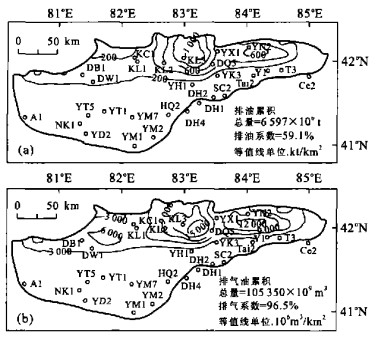Quantitative Simulation of Hydrocarbon Migration in Kuqa Depression
-
摘要: 为了给库车坳陷的油气勘探提供定量依据, 使用盆地模拟软件BASIMS对该坳陷的地史、热史、成岩史、生烃史、排烃史及运聚史进行了全定量模拟.其中油气初次运移的模拟使用简易而实用的方法, 即: 对于油气初次运移, 采用沉积压实渗流法求排油、物质平衡法求排气; 对于油气二次运移, 采用基于浮力驱动及达西定律的拟三维运聚模型.除了讨论这些数值方法的敏感性参数(参数敏感性与风险分析、排烃分配因子、断层及不整合面的渗透率、油气储集单元的确定) 外, 给出了排烃史和运聚史的模拟结果, 其聚集量的模拟结果不仅在数量上而且在位置上与实际情况符合, 尤其是预测出的几个有利勘探目标后来被勘探结果所证实Abstract: The histories of stratigraphic burial, geotherm, diagenesis, hydrocarbon generation, expulsion and migration-accumulation are simulated quantitatively by means of the basin modeling software of BASIMS in order to provide the quantitative data for oil and gas exploration in Kuqa depression. Of them, hydrocarbon primary migration is simulated by the easy and practical methods, i.e. sedimentary compaction-filtration method is used to calculate the amount of expelled oil and the mass balance method to calculate the amount of expelled gas. The pseudo 3-D migration-accumulation model based on buoyancy and Darcy's Law is used to simulate on secondary hydrocarbon migration. The sensible parameters (parameter sensitivity and risk analyses, distribution ratio of hydrocarbons expelled, permeabilities in fault and unconformity zones, and determination of reservoir cell) in these numerical methods are discussed, and hydrocarbon expulsion and migration-accumulation histories have been simulated in detail. The modeling results are in agreement with the real pools not only on quantities but also on locations, and especially some predicted prospects have been proved by explorations later.
-
图 1 库车坳陷构造及油气田分布(据赵靖舟和戴金星修改, 2002)
Fig. 1. Structures and reservoirs in Kuqa depression (modified from Zhao and Dai, 2002)
表 1 库车坳陷烃源层J-T在主要储集层中的排烃分配因子
Table 1. Distribution ratios of hydrocarbons expelled from source-rock formations J-T

表 2 库车坳陷E油层和K气层所分布的油气田
Table 2. Oil/gas fields that have oil/gas reservoirs in Kuqa depression

表 3 库车坳陷烃类的生、排、聚总量及资源量
Table 3. Total amount of hydrocarbons generated, expelled, accumulated and reserves in place in Kuqa depression

-
Huang, W.L., Longo, J.M., Pevear, D.R., 1993. An experimentally derived kinetic model for smectite-to-illite conversion and its use as a geothermometer. Clays and Clay Minerals, 41(2): 162-177. doi: 10.1346/CCMN.1993.0410205 Jourde, H., Flodin, E.A., Aydin, A., et al., 2002. Computing permeability of fault zonesin eolian sandstone from outcrop measurements. AAPG Bulletin, 86(7): 1187-1200. https://pubs.geoscienceworld.org/aapgbull/article-abstract/86/7/1187/39999/Computing-Permeability-of-Fault-Zones-in-Eolian Mi, S.Y., Shi, G.R., Li, A.M., 1994. Expanding migration model on organic gas generation. Petroleum Exploration and Development, 21(6): 35-39(in Chinese with English abstract). Shi, G.R., Li, A.M., Zhang, Q.C., 1997a. New advancement in basin modelling technology(Ⅰ): Present developing situation. Petroleum Exploration and Development, 24(3): 38-40(in Chinese with English abstract). Shi, G.R., Li, A.M., Zhang, Q.C., 1997b. New advancement in basin modelling technology(Ⅱ): Separate formation 2-D plate models for simulation of hydrocarbon migration. Petroleum Exploration and Development, 24(4): 33-37 (in Chinese with English abstract). Shi, G. R., 1999. Numerical methods of petroliferous basin modeling(2nd edition). Petroleum Industry Press, Beijing, 127-133, 145-155(in Chinese). Shi, G. R., 2000. Numerical methods of petroliferous basin modeling(2nd edition). Petroleum Industry Press, Beijing, 127-215. Shipton, Z.K., Evans, J.P., Robeson, K.R., et al., 2002. Structural heterogeneity and permeability in faulted eolian sandstone: Implications for subsurface modeling of faults. AAPG Bulletin, 86(5): 863-883. https://www.researchgate.net/publication/29813228_Structural_heterogeneity_and_permeability_in_faulted_eolian_sandstone_Implications_for_subsurface_modeling_of_faults Sweeney, J.J., Braun, R.L., Burnham, A.K., et al., 1995. Chemical kinetic model of hydrocarbon generation, expulsion, and destruction applied to the Maracaibo basin. AAPG Bulletin, 79(10): 1515-1532. https://pubs.geoscienceworld.org/aapgbull/article-abstract/79/10/1515/39086/chemical-kinetic-model-of-hydrocarbon-generation Thomsen, R.O., 1998. Aspects of applied basin modeling: Sensitivity analysis and scientific risk. In: Düppenbecker, S.J., Iliffe, J.E., eds., Basin modelling: Practice and progress. Spec. Pub. No. 141, Geol. Soc., London, 209-221. Walderhaug, O., 1996. Kinetic modeling of quartz cementation and porosity loss in deeply burial sandstone reservoirs. AAPG Bulletin, 80(5): 731-745. Waples, D.W., 1998. Basin modelling: How well have we done? In: Düppenbecker, S.J., Iliffe, J.E., eds., Basin modelling: Practice and progress. Spec. Pub. No. 141, Geol. Soc., London, 1-14. Yang, M.H., Jin, Z.J., Lü, X.X., et al., 2002. Kelasu triangle zone and its hydrocarbon potential in Kuqa thrust-and-fold belts, Tarim basin. Earth Science-Journal of China University of Geosciences, 27(6): 745-750(in Chinese with English abstract). Zhang, Q.C., Shi, G.R., Mi, S.Y., et al., 2001. Dynamic nu- merical modelling of petroleum system(Ⅱ): A case study on the Manjar petroleum system, Tarim basin. Petroleum Exploration and Development, 28(5): 33-36(in Chinese with English abstract). Zhao, J.Z., Dai, J.X., 2002. Timing and filling history of natural gas reservoirs in Kuqa foreland thrust belt, Tarim basin. Acta Petrolei Sinica, 23(2): 6-10(in Chinese with English abstract). Zhou, X.X., 2001. The reservoir-forming process and model in the Kuqa petroleum system. Petroleum Exploration and Development, 28(2): 8-10(in Chinese with English abstract). https://www.sciencedirect.com/science/article/pii/S1876380409601324 米石云, 石广仁, 李阿梅, 1994. 有机质成气膨胀运移模型研究. 石油勘探与开发, 21(6): 35-39. https://www.cnki.com.cn/Article/CJFDTOTAL-SKYK406.006.htm 石广仁, 李阿梅, 张庆春, 1997a. 盆地模拟技术新进展(一)-国内外发展状况. 石油勘探与开发, 24(3): 38-40. https://www.cnki.com.cn/Article/CJFDTOTAL-SKYK199703012.htm 石广仁, 李阿梅, 张庆春, 1997b. 盆地模拟技术新进展(二)-油气运聚平面分层模拟方法. 石油勘探与开发, 24(4): 33-37. https://www.cnki.com.cn/Article/CJFDTOTAL-SKYK199704009.htm 石广仁, 1999. 油气盆地数值模拟方法(第二版). 北京: 石油工业出版社, 127-133, 145-155. 杨明慧, 金之钧, 吕修祥, 等, 2002. 库车褶皱冲断带克拉苏三角带及其油气潜力. 地球科学——中国地质大学学报, 27(6): 745-750. https://www.cnki.com.cn/Article/CJFDTOTAL-DQKX200206016.htm 张庆春, 石广仁, 米石云, 等, 2001. 油气系统动态数值模拟研究(二)—塔里木盆地满加尔油气系统模拟分析. 石油勘探与开发, 28(5): 33-36. doi: 10.3321/j.issn:1000-0747.2001.05.009 赵靖舟, 戴金星, 2002. 库车前陆逆冲带天然气成藏期与成藏史. 石油学报, 23(2): 6-10. https://www.cnki.com.cn/Article/CJFDTOTAL-SYXB200202001.htm 周兴熙, 2001. 库车油气系统成藏作用与成藏模式. 石油勘探与开发, 28(2): 8-10. doi: 10.3321/j.issn:1000-0747.2001.02.003 -










 下载:
下载:






